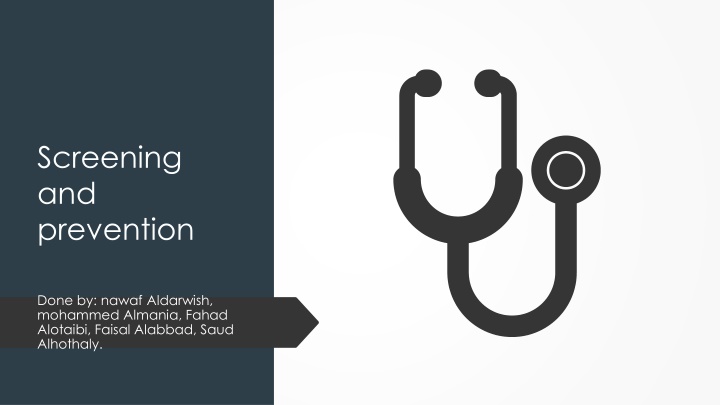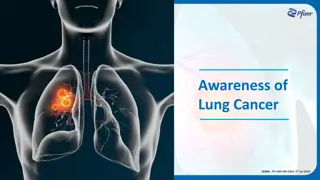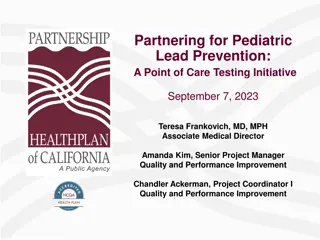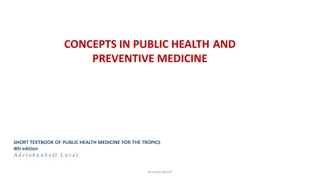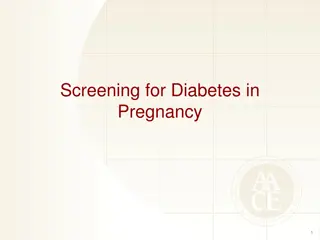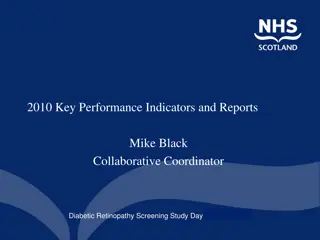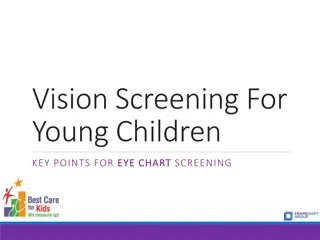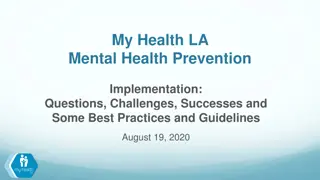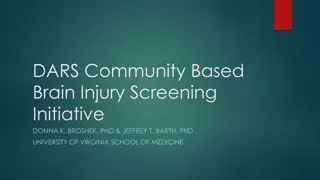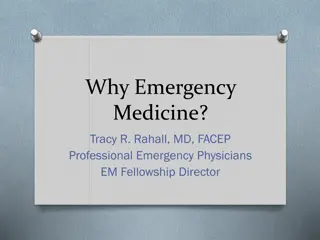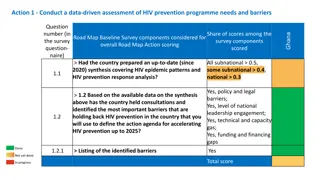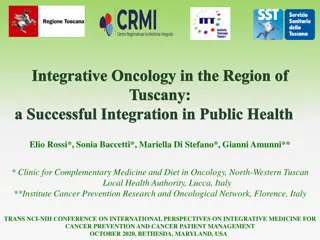Comprehensive Guide to Screening and Prevention in Family Medicine
This comprehensive guide explores the definitions, uses, and levels of screening and prevention in family medicine. It covers the criteria for screening tests, types of screening, examples of targeted populations, and approaches to preventing common problems in primary care. The content discusses the pros and cons of screening, recommendations for screening programs in adults (such as breast cancer, colorectal cancer, cervical cancer, prostate cancer, and osteoporosis), and reviews the vaccination schedule from the Saudi Ministry of Health. Multiple-choice questions also test knowledge on various screening and prevention topics.
Download Presentation

Please find below an Image/Link to download the presentation.
The content on the website is provided AS IS for your information and personal use only. It may not be sold, licensed, or shared on other websites without obtaining consent from the author.If you encounter any issues during the download, it is possible that the publisher has removed the file from their server.
You are allowed to download the files provided on this website for personal or commercial use, subject to the condition that they are used lawfully. All files are the property of their respective owners.
The content on the website is provided AS IS for your information and personal use only. It may not be sold, licensed, or shared on other websites without obtaining consent from the author.
E N D
Presentation Transcript
Screening and prevention Done by: nawaf Aldarwish, mohammed Almania, Fahad Alotaibi, Faisal Alabbad, Saud Alhothaly.
Define screening / prevention and its use in family medicine. Identify levels of prevention in primary care practice. Recognize the criteria of screening test. Identify screening types and illustrate examples of targeted people. Explain appropriate approach for prevention and screening of common problems in primary care. Objectives: Indicate the pros and cons of screening. Summaries the recommendations for screening programs in adults e.g. Breast cancer, Colorectal ca, cervical ca, Prostate ca, osteoporosis etc. Review the local vaccination schedule from Saudi M.O.H.
A/Which one of the following is multipurpose screening: 1-Screening in pregnant woman for VDRL, HIV and HBV by serology. 2-CBC and Hb electrophoresis in sickle cell anemia. 3-Screening for familial cancers. 4-Screen school children for visual defect.
B/which of the following is screening test for lung cancer? 1-low dose ct chest 2-tumor markers 3-chest x-ray 4-spirometry
C/which one of the following is a primary prevention of colorectal cancer? 1-High intake of fibers 2-High intake of red meats 3-Sitting regularly for prolonged periods 4- alcohol use
D/ Which one of the following is not part of Wilson- Junger criteria? 1. Natural history of illness is well understood 2. Detectable at early age 3. Acceptable to the population 4. Test has to be highly specific
E/2 years old boy came with Accommodative esotropia, the physician told the parent that he should wear glasses to prevent amblyopia, what type of prevention is it? 1-primary prevention 2-secondary prevention 3- tertiary prevention
Define screening / prevention and its use in family medicine.
Screening: according to WHO: According to Oxford handbook of general practice: The ability to diagnose and treat a potentially serious condition at an early stage when it is still treatable. An early disease detection or Secondary Prevention. Screening is defined as the presumptive identification of unrecognized disease in an apparently healthy, asymptomatic population by means of tests, examinations or other procedures that can be applied rapidly and easily to the target population.
Aim of screening: To be able to diagnose and treat a potentially serious condition at an early stage when it is still treatable. To prevent or delay the development of advanced disease in the subset with preclinical disease.
Merriam-Websters dictionary defines prevention as the act of preventing or hindering and the act or practice of keeping something from happening. Prevention: Physicians efforts are aimed at preventing the untimely occurrences of the 5 Ds: death, disease, disability, discomfort, and dissatisfaction.
Identify levels of prevention in primary care practice.
Primary prevention Secondary prevention Levels of prevention: Tertiary prevention
Primary prevention: Intervening before health effects occur. (so we intervene before the disease occur.) o Examples: Vaccination and post exposure prophylaxis. Nutrition intervention and food supplementation. Health education. Sanitation of the environment. Lifestyle modification. Inclusion of disease prevention programmes at primary and specialized health care levels, such as access to preventive services (ex. counselling).
Secondary prevention: Screening to identify diseases in the earliest stages, before the onset of signs and symptoms. o Examples: Population-based screening programmes for early detection of diseases. Provision of maternal and child health programmes, including screening and prevention of congenital malformations. Provision of chemoprophylactic agents to control risk factors.
Tertiary prevention: Managing disease post diagnosis to slow or stop disease progression. (Prevention of complications once the disease is present). o Examples: Rehabilitation programs. (post stroke patients). Palliative therapy. Limiting complications and disability in patients with established disease. (uncontrolled DM led to amputation).
Uses in family medicine: One of the fundamental goals of primary care medicine is the prevention or early detection of disease through screening. Screening can lead to interventions that may decrease morbidity and mortality, but it can also lead to increased morbidity and mortality if performed inappropriately. Screening tests are available for many common diseases and encompass many approaches including: o Biochemical (e.g., cholesterol, glucose), o Physiologic (e.g., blood pressure, growth curves), o Radiologic (e.g., mammogram, bone densitometry), o Cytologic (e.g., Pap smear).
Recognize the criteria of screening test.
Screening criteria: We have two screening criteria: WHO criteria for good screening tests. Wilson-Jungner Criteria for screening.
WHO criteria for a good screening test: The condition screened for should be an important one. There should be an acceptable treatment for patients with the disease. The facilities for diagnosis and treatment should be available. There should be a recognized latent or early symptomatic stage.
Cont. There should be a suitable test or examination which has few false positives (specificity) and few false negatives (sensitivity). The test or examination should be acceptable to the population. The cost, including diagnosis and subsequent treatment, should be economically balanced in relation to expenditure on medical care as a whole.
The condition being screened for should be an important health problem. The natural history of the condition should be well understood. There should be a detectable early stage. Wilson- Jungner Criteria for screening: Treatment at an early stage should be of more benefit than at a later stage. A suitable test should be devised for the early stage.
The test should be acceptable. Intervals for repeating the test should be determined. Adequate health service provision should be made for the extra clinical workload resulting from screening. Cont. The risks, both physical and psychological, should be less than the benefits. The costs should be balanced against the benefits.
Identify screening types and illustrate examples of targeted people.
Selective or high risk targeted screening. Mass screening. Multiphasic screening. Multipurpose screening. Types of screening: Case finding or opportunistic screening.
Mass screening: Application of screening test to large, unselected population. Everyone is screened regardless of the probability of having the disease or condition. Examples: o Visual defect in school children. o Mammography for women above 40 years of age. o Newborn screening program.
It is applied selectively to high risk groups. Examples: o Screening fetus for Down s syndrome in a mother who already has a baby with Down s syndrome. Selective or high risk targeted screening: o Screening for familial cancers. o Screening for cancer cervix in low socioeconomical groups. o Screening for HIV in risk groups.
Multiphasic screening: The screening in which various diagnostic procedures are done during the same screening program, to carry out screening tests for a single diseases. The procedure may include questionnaire, clinical examination and a range of measurements and investigations. Examples: o CBC and Hb electrophoresis for Sickle cell anemia. o PSA and PR for prostate cancer. o FBS and GTT for DM.
The screening of a population by more than one test done simultaneously to detect more than one disease. Multipurpose screening: Examples: o Screening in pregnant woman for VDRL, HIV and HBV by serology.
Screening of persons who come to health practitioner for some other purpose. Case finding or opportunistic screening: Examples: o Screening for high blood pressure when a patient comes in for a flu shot.
What are Preventive Services? Preventive services consist of healthcare services that include check-ups, patient counseling, and screenings to prevent illness, disease and other health-related problems. The U.S. Preventive Services Task Force grades :
The USPSTF defines certainty as: "likelihood that the USPSTF assessment of the net benefit of a preventive service is correct." The net benefit is defined as benefit minus harm of the preventive service as implemented in a general, primary care population. The U.S. Preventive Services Task Force levels of evidence :
Summaries the recommendations for screening programs in adults.
Cholesterol measurements: Cholesterol screening is performed by a blood test. People with high cholesterol measurements from a blood sample have a higher risk for cardiovascular disease (CVD) than those with cholesterol in the normal range.
Papsmears are samples of cells taken from the cervix in women to look for cellularchanges indicative of cervical cancer. Pap test (also called Pap smears):
This blood test measures the prostate specific antigen (PSA) levels in the blood. Antigens are any substances that evoke responses from a person's immune system. The prostate specific antigen levels can be elevated in the presence of prostate cancer. However, it is important to understand that other benignprostate conditions may also elevate PSA, such as benign prostatic hyperplasia (BPH), which is noncancerous swelling of the prostate. Prostate specific antigen (PSA):
Mammography is the process of using low-energy X-rays to examine the human breast The goal of mammography is the early detection of breastcancer, typically through detection of characteristic masses or microcalcifications. Mammography:
Colonoscopy or coloscopy is the endoscopic examination of the large bowel and the distalpart of the smallbowel with a CCD camera or a fiber optic camera on a flexible tube passed through the anus. It can provide a visual diagnosis and grants the opportunity for biopsy or removal of suspected colorectal cancer lesions. Colonoscopy can removepolyps as small as one millimeter or less. Once polyps are removed, they can be studied with the aid of a microscope to determine if they are precancerous or not. Colonoscopy:
There are two simple tests used in diabetes screening, The fasting plasma glucose test involves checking the level of glucose in your blood while you are fasting, The oral glucose tolerance test (OGTT) involves drinking a sugarysolutiontwo hours before you have your blood drawn. Diabetes or prediabetes:
American academy of family physicians: Women aged 65 years and older. Women aged 60 years and older at increased risk for osteoporotic fractures. Osteoporosis: United States Preventive Services Task Force: All women aged 65 and older. In addition, they recommend screening in younger women whose fracture risk is equal to or greater than that of 65 years old.
National osteoporosis foundation: All women aged 65 years and older. All men aged 70 years and older. Younger postmenopausal women, women in menopausaltransition and men aged 50 to 69 years of age with clinical risk factor for fracture. Continue Adults who have fractureafter the age of 50 years. Adults with a condition (e.g. Rheumatoid arthritis) or taking medications (e.g. Steroids) associated with low bone mass or bone loss.
Explain appropriate approach for prevention and screening of common problems in primary care.
Screening and Prevention method: Conventional Digital Mammography. Population: Women above 40 years of age. Screening intervals: Breast cancer: Annual screening mammography should be offered to women between 40 and 44 years of age. Annual screening with mammography should be initiated at 45 years of age in women at average risk. For women 55 years and older, biennial screening is the preferred approach, with the option to screen annually. Women should continue screening mammography as long as their overall health is good and they have a life expectancy of 10 years or more.
Cervical cancer: Population Screening test or procedure Screening Intervals 21 to 29 years of age Pap test Every three years Every five years with both the HPV test and the Pap test (preferred) or every three years with the Pap test alone (acceptable) 30 to 65 years of age Pap test and HPV DNA test Women 66 years or older who have had three or more consecutive negative Pap tests or two or more consecutivenegative HPV and Pap tests within the past 10 years, with the most recent test occurring in the previous five years, should stop cervical cancer screening 66 years or older Pap test and HPV DNA test
Endometrial cancer: No Screening test or procedure. Targeted population: women, at menopause. At the time of menopause, women should be informed about risks and symptoms of endometrial cancer and strongly encouraged to report any unexpectedbleeding or spotting to their physicians.
Screening test or procedure: Low dose CT chest. Targeted population: Current or former smokers 55 to 74 years of age in good health with at least a 30 pack-year history. Lung cancer: Clinicians should initiate a discussion about annual lung cancer screening with apparently healthy patients 55 to 74 years of age who have at least a 30 pack-year smoking history and who currently smoke or have quit within the past 15 years; a process of informed and shared decision making with a clinician related.
Screening test or procedure: See Next slide. Men and women, 45 to 85 years. Targeted population: Colorectal cancer: From 76 to 85 screening should be based on Patient s preference, Life expectancy, Health and Screening history. Screening is discouraged after the age of 85 due to risk of increased mortality & screening complication.
Screening methods for Colorectal cancer: Screening test or procedure Screening Intervals Guaiac-based FOBT with at least 50% sensitivity for cancer, or fecal immunochemical test with at least 50% sensitivity for cancer Annually OR Multitarget stool DNA test Every three years Every five years, flexible sigmoidoscopy can be performed alone, or consideration can be given to combining flexible sigmoidoscopy performed every five years with a highly sensitive FOBT or fecal immunochemical test performed annually OR Flexible sigmoidoscopy OR Double-contrast barium enema Every five years OR Colonoscopy Every 10 years OR CT colonography Every five years
Prostate specific antigen test with or without digital rectal examination. Screening test or procedure: Men from55 to 69 years of age. Prostate cancer: Targeted population: Men who have at least a 10-year life expectancy, screening should not occur without an informed decision-making process due to the potential benefits, risks and uncertainties associated with the screening.
